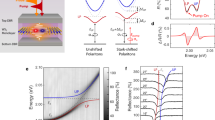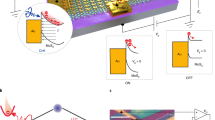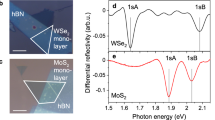Abstract
Spin–orbit coupling is a fundamental mechanism that connects the spin of a charge carrier with its momentum. In the optical domain, an analogous synthetic spin–orbit coupling is accessible by engineering optical anisotropies in photonic materials. Both yield the possibility of creating devices that directly harness spin and polarization as information carriers. Atomically thin transition metal dichalcogenides promise intrinsic spin-valley Hall features for free carriers, excitons and photons. Here we demonstrate spin- and valley-selective propagation of exciton-polaritons in a monolayer of MoSe2 that is strongly coupled to a microcavity photon mode. In a wire-like device we trace the flow and helicity of exciton-polaritons expanding along its channel. By exciting a coherent superposition of K and K′ tagged polaritons, we observe valley-selective expansion of the polariton cloud without either an external magnetic field or coherent Rayleigh scattering. The observed optical valley Hall effect occurs on a macroscopic scale, offering the potential for applications in spin-valley-locked photonic devices.
This is a preview of subscription content, access via your institution
Access options
Access Nature and 54 other Nature Portfolio journals
Get Nature+, our best-value online-access subscription
$29.99 / 30 days
cancel any time
Subscribe to this journal
Receive 12 print issues and online access
$259.00 per year
only $21.58 per issue
Buy this article
- Purchase on Springer Link
- Instant access to full article PDF
Prices may be subject to local taxes which are calculated during checkout



Similar content being viewed by others
Data availability
The data that support the findings of this study are available from the corresponding author on reasonable request.
References
Xiao, D. et al. Coupled spin and valley physics in monolayers of MoS2 and other group-VI dichalcogenides. Phys. Rev. Lett. 108, 196802 (2012).
Xu, X., Yao, W., Xiao, D. & Heinz, T. F. Spin and pseudospins in layered transition metal dichalcogenides. Nat. Phys. 10, 343–350 (2014).
Dyakonov, M. I. Spin Physics in Semiconductors (Springer, 2008).
Mak, K. F., He, K., Shan, J. & Heinz, T. F. Control of valley polarization in monolayer MoS2 by optical helicity. Nat. Nanotechnol. 7, 494–498 (2012).
Cao, T. et al. Valley-selective circular dichroism of monolayer molybdenum disulphide. Nat. Commun. 3, 885–887 (2012).
Mak, K. F., McGill, K. L., Park, J. & McEuen, P. L. The valley Hall effect in MoS2 transistors. Science 344, 75–79 (2014).
Onga, M., Zhang, Y., Ideue, T. & Iwasa, Y. Exciton Hall effect in monolayer MoS2. Nat. Mater. 16, 1193–1198 (2017).
Wang, G. et al. Control of exciton valleycoherence in transition metal dichalcogenide monolayers. Phys. Rev. Lett. 117, 187401 (2016).
Ye, Z., Sun, D. & Heinz, T. F. Optical manipulation of valley pseudospin. Nat. Phys. 13, 26–30 (2017).
Schaibley, J. R., Yu, H., Yao, W. & Xu, X. Valleytronics in 2D materials. Nat. Rev. Mater. 1, 16055 (2016).
Wang, G. et al. Colloquium: excitons in atomically thin transition metal dichalcogenides. Rev. Mod. Phys. 90, 21001 (2018).
Glazov, M. M. et al. Exciton fine structure and spin decoherence in monolayers of transition metal dichalcogenides. Phys. Rev. B 89, 201302 (2014).
Glazov, M. M. et al. Spin and valley dynamics of excitons in transition metal dichalcogenide monolayers. Phys. Stat. Solidi 252, 2349–2362 (2015).
Maialle, M. Z., Silva, E. & Sham, L. J. Exciton spin dynamics in quantum-wells. Phys. Rev. B 47, 15776 (1993).
Kioseoglou, G., Hanbicki, A. T., Currie, M., Friedman, A. L. & Gunlycke, D. Valley polarization and intervalley scattering in monolayer MoS2. Appl. Phys. Lett. 101, 221907 (2012).
Zhu, B., Zeng, H., Dai, J., Gong, Z. & Cui, X. Anomalously robust valley polarization and valley coherence in bilayer WS2. Proc. Natl Acad. Sci. USA 111, 11606–11611 (2014).
Jones, A. M. et al. Optical generation of excitonic valley coherence in monolayer WSe2. Nat. Nanotechnol. 8, 6–10 (2013).
Hanbicki, A. T. et al. Anomalous temperature-dependent spin-valley polarization in monolayer WS2. Sci. Rep. 6, 18885 (2016).
Wang, G. et al. Polarization and time-resolved photoluminescence spectroscopy of excitons in MoSe2 monolayers. Appl. Phys. Lett. 106, 112101 (2015).
Dufferwiel, S. et al. Valley-addressable polaritons in atomically thin semiconductors. Nat. Photon. 11, 497–501 (2017).
Seyler, K. L. Electrical control of second-harmonic generation in a WSe2 monolayer transistor. Nat. Nanotechnol. 10, 1–5 (2015).
Dufferwiel, S. et al. Valley coherent exciton-polaritons in a monolayer semiconductor. Nat. Commun. 9, 4797 (2018).
Chen, Y., Cain, J. D., Stanev, T. K., Dravid, V. P. & Stern, N. P. Valley-polarized exciton-polaritons in a monolayer semiconductor. Nat. Photon. 11, 431–435 (2017).
Sun, Z. et al. Optical control of room-temperature valley polaritons. Nat. Photon. 11, 491–496 (2017).
Lundt, N. et al. Observation of macroscopic valley-polarized monolayer exciton-polaritons at room temperature. Phys. Rev. B 96, 241403 (2017).
Lundt, N. et al. Valley polarized relaxation and upconversion luminescence from Tamm-plasmon trion-polaritons with a MoSe2 monolayer. 2D Mater. 4, 25096 (2017).
Bleu, O., Solnyshkov, D. D. & Malpuech, G. Optical valley Hall effect based on transitional metal dichalcogenide cavity polaritons. Phys. Rev. B 96, 165432 (2017).
Barachati, F. et al. Interacting polariton fluids in a monolayer of tungsten disulfide. Nat. Nanotechnol. 13.10, 906 (2018).
Kulig, M. et al. Exciton diffusion and halo effects in monolayer semiconductors. Phys. Rev. Lett. 120, 207401 (2018).
Cadiz, F., Paget, D., Urbaszek, B. & Marie, X. Exciton diffusion in WSe2 monolayers embedded in a van der Waals heterostructure. Appl. Phys. Lett. 112, 152106 (2018).
Dyakonov, M. I. & Perel, V. I. Current-induced spin orientation of electrons in semiconductors. Phys. Lett. 35, 1–2 (1971).
Kavokin, A., Malpuech, G. & Glazov, M. Optical spin Hall effect. Phys. Rev. Lett. 95, 136601 (2005).
Castellanos-Gomez, A. et al. Deterministic transfer of two-dimensional materials by all-dry viscoelastic stamping. 2D Mater. 1, 11002 (2014).
Kulakovskii, V. D. et al. Bose–Einstein condensation of exciton polaritons in high Q planar microcavities with GaAs quantum wells. JETP Lett. 92, 595–599 (2010).
Glazov, M. M. et al. Intrinsic exciton-state mixing and nonlinear optical properties in transition metal dichalcogenide monolayers. Phys. Rev. B 95, 35311 (2017).
Wang, G. et al. Exciton states in monolayer MoSe2: impact on interband transitions. 2D Mater. 2, 45005 (2015).
Schmutzler, J. et al. Nonlinear spectroscopy of exciton-polaritons in a GaAs-based microcavity. Phys. Rev. B 90, 1–6 (2014).
Simon, H. J. & Bloembergen, N. Second-harmonic light generation in crystals with natural optical activity. Phys. Rev. 171, 1104–1114 (1968).
Jakubczyk, T. et al. Radiatively limited dephasing and exciton dynamics in MoSe2 monolayers revealed with four-wave mixing microscopy. Nano Lett. 16, 5333–5339 (2016).
Cadiz, F. et al. Excitonic linewidth approaching the homogeneous limit in MoS2-based van der Waals heterostructures. Phys. Rev. X 7, 21026 (2017).
Wang, G. et al. Giant enhancement of the optical second-harmonic emission of WSe2 monolayers by laser excitation at exciton resonances. Phys. Rev. Lett. 114, 97403 (2015).
Leyder, C. et al. Observation of the optical spin Hall effect. Nat. Phys. 3, 628–631 (2007).
Maragkou, M. et al. Optical analogue of the spin Hall effect in a photonic cavity. Opt. Lett. 36, 1095–1097 (2011).
Baranowski, M. et al. Dark excitons and the elusive valley polarization in transition metal dichalcogenides. 2D Mater. 4, 025016 (2017).
Manni, F. et al. Spin-to-orbital angular momentum conversion in semiconductor microcavities. Phys. Rev. B 83, 241307 (2011).
Huang, S. et al. Topologically protected helical states in minimally twisted bilayer graphene. Phys. Rev. Lett. 121, 37702 (2018).
Klembt, S. et al. Exciton-polariton topological insulator. Nature 562, 552–556 (2018).
Schmidt., D. et al. Tracking dark excitons with exciton polaritons in semiconductor microcavities. Phys. Rev. Lett. 122, 047403 (2019).
Tassone, F. & Yamamoto, Y. Exciton-exciton scattering dynamics in a semiconductor microcavity and stimulated scattering into polaritons. Phys. Rev. B 59, 10830 (1999).
Shahnazaryan, V., Iorsh, I., Shelykh, I. A. & Kyriienko, O. Exciton-exciton interaction in transition-metal dichalcogenide monolayers. Phys. Rev. B 96, 115409 (2017).
Acknowledgements
C.S. acknowledges support from the ERC (Project unLiMIt-2D). The Würzburg group acknowledges support from the State of Bavaria. A.V.K. acknowledges support from Westlake University (Project No. 041020100118). A.V.K. acknowledges the St Petersburg State University for research grant ID 40847559. E.S. acknowledges support from the Grant of the President of the Russian Federation for state support of young Russian scientists No. MK-2839.2019.2 and RFBR Grant No. 17-52-10006. S.K. acknowledges support from the EU (Marie Curie Project TOPOPOLIS). Q.Y. and S.T. acknowledge funding from NSF DMR-1838443 and DMR-1552220. M.M.G. acknowledges partial support from RFBR Project No. 17-02-00383.
Author information
Authors and Affiliations
Contributions
N.L. exfoliated, identified and transferred the monolayer and designed and fabricated the microcavity. Y.Q. and S.T. synthesized the bulk crystal. N.L., Ł.D., S.K., M.K. and P.S. performed experiments. N.L., S.K., M.K., J.B., M.R. and C.S. analysed and interpreted the experimental data, supported by all co-authors. E.S., M.M.G. and A.V.K. provided the theory. N.L. and C.S. wrote the manuscript, with input from all co-authors. C.S. and S.H. initiated the study and guided the work.
Corresponding author
Ethics declarations
Competing interests
The authors declare no competing interests.
Additional information
Publisher’s note: Springer Nature remains neutral with regard to jurisdictional claims in published maps and institutional affiliations.
Rights and permissions
About this article
Cite this article
Lundt, N., Dusanowski, Ł., Sedov, E. et al. Optical valley Hall effect for highly valley-coherent exciton-polaritons in an atomically thin semiconductor. Nat. Nanotechnol. 14, 770–775 (2019). https://doi.org/10.1038/s41565-019-0492-0
Received:
Accepted:
Published:
Issue Date:
DOI: https://doi.org/10.1038/s41565-019-0492-0
This article is cited by
-
Inducing room-temperature valley polarization of excitonic emission in transition metal dichalcogenide monolayers
npj 2D Materials and Applications (2024)
-
Exciton polariton interactions in Van der Waals superlattices at room temperature
Nature Communications (2023)
-
Interspecies exciton interactions lead to enhanced nonlinearity of dipolar excitons and polaritons in MoS2 homobilayers
Nature Communications (2023)
-
Manipulating nonlinear exciton polaritons in an atomically-thin semiconductor with artificial potential landscapes
Light: Science & Applications (2023)
-
Deterministic and replaceable transfer of silver flakes for microcavities
Frontiers of Physics (2023)



